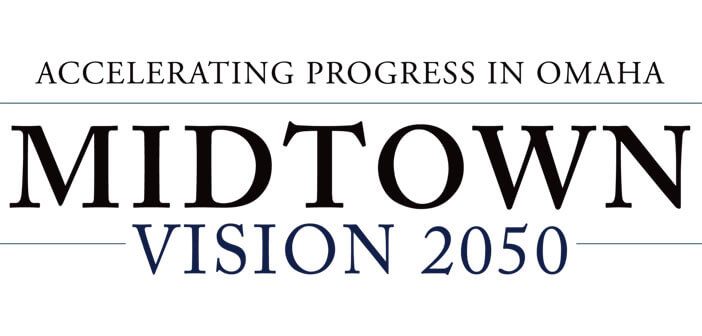Midtown 2050 Corporation Formed to Accelerate Midtown Revitalization, Modernization
A new development corporation – Midtown 2050 Corporation – has been formed to coordinate and accelerate the next phase of midtown Omaha’s revitalization and progression into a dynamic, transit-oriented urban community.
Midtown Vision 2050 sprang from discussions between midtown anchors Mutual of Omaha and UNMC about pursuing a cohesive vision for the future of midtown Omaha. They engaged an urban planning firm, DPZ Partners LLC, to evaluate midtown and set broad new goals for the community. One element of the vision plan called for the formation of an independent midtown development corporation – thus the launch of Midtown 2050 Corporation. A not-for-profit Nebraska corporation, it will lead the vision implementation process and coordinate crucial private and public investment.
The Midtown 2050 Board includes representation from key midtown stakeholders: Creighton University, Kiewit Corporation, Midtown Neighborhood Alliance, Heritage Services, Mutual of Omaha, Nebraska Medicine and the University of Nebraska Medical Center. Ken Cook, president of East Campus Realty LLC , the Mutual of Omaha subsidiary behind Midtown Crossing, will serve as chairman of Midtown 2050 Corporation. Former U.S. Congressman Brad Ashford has been appointed Midtown 2050 Corporation president and executive director. Joining Cook on the Midtown 2050 Corporation Board are Vice Chairman Alan Lincoln, real estate manager at Kiewit Corporation; Sue Morris, president of Heritage Services; Diana Failla, president of the Midtown Neighborhood Alliance; the Rev. Daniel Hendrickson, S.J., president of Creighton University; Jeffrey P. Gold, M.D., UNMC chancellor; and Daniel DeBehnke, M.D., president and CEO of Nebraska Medicine.
The Midtown Vision 2050 vision plan builds on and seeks to accelerate the momentum seeded by the Destination Midtown initiative, construction of $365 million Midtown Crossing, UNMC’s vertical growth, the re-emergence of the Blackstone District, and residential redevelopment spearheaded by companies such as Urban Village. Midtown 2050’s area of focus is defined as Center Street to the south, 48th Street to the west, Cuming Street to the north and 20th Street to the east.
Based on the recent work of experienced urban planners, the impact of implementing the Midtown Vision 2050 plan (for the five years following the initial streetcar and related restoration/development construction phase) is estimated to be an additional $8.7 billion in sales activity, boosting wages by $3.9 billion. This is estimated to contribute a minimum of $326 million to state and local tax collections for the five-year period. This compares to an estimated annual $6 million operating budget for the entire streetcar system over the same five-year period.

